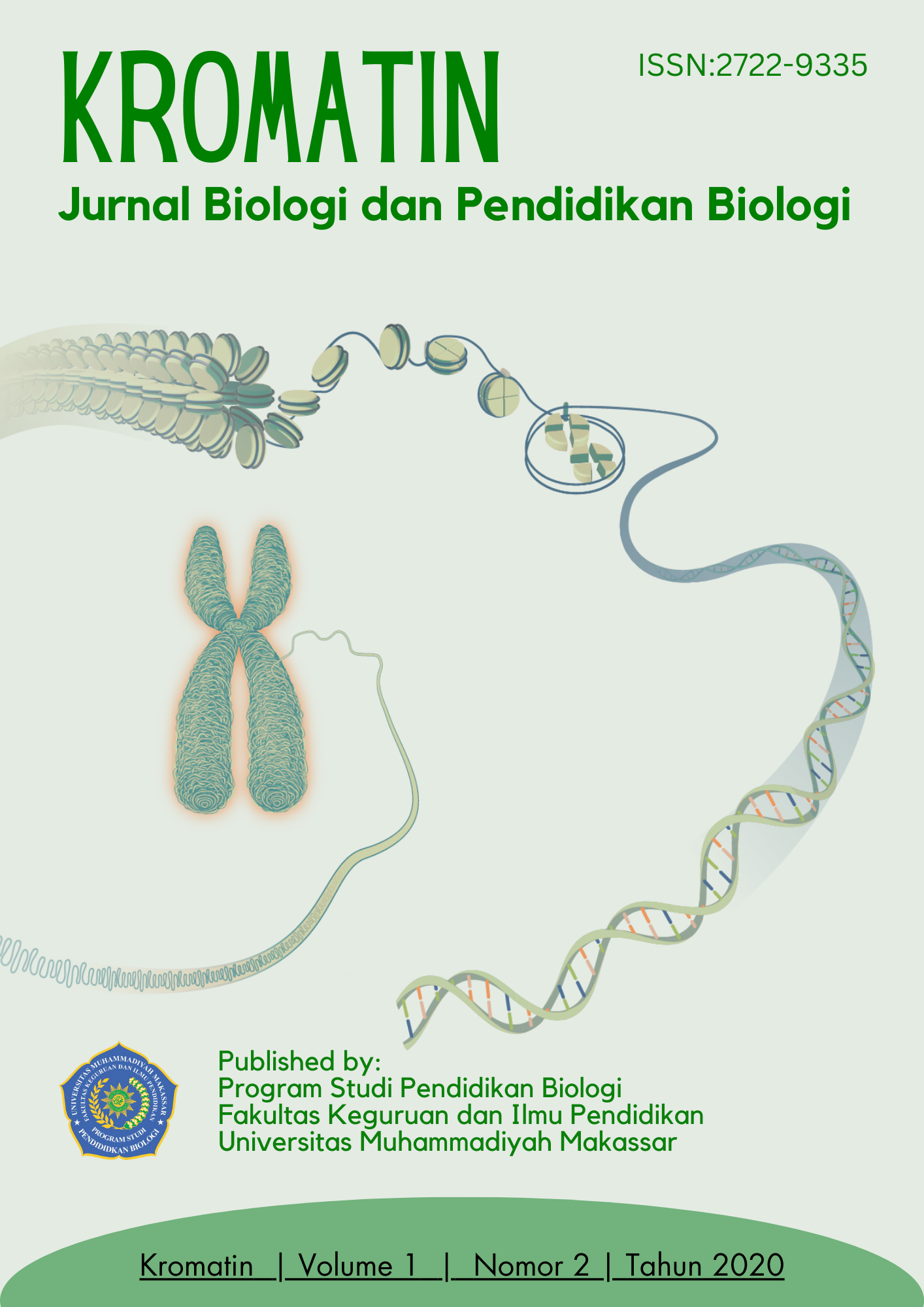Pengaruh Model Pmbelajaran Example Non Example Melalui Online Terhadap Hasil Belajar Kognitif Siswa Materi Sistem Pernapasan Manusia Kelas XI SMA Negeri 8 Gowa
DOI: https://doi.org/10.26618/z7jckp12
Abstract
This research is a quasi-experimental research which aims to determine the effect of using the Example non Example model on the cognitive learning outcomes of students in class XI MIA SMA Negeri 8 Gowa on the material of the human respiratory system. Data collection was done by giving pretest and posttest. The data were analyzed with descriptive statistics and inferential statistics with the help of SPSS (Statistical Product and Service Solutions) version 24. above, it was concluded that in the experimental class, the range <75, there were 6 students who scored in the category of less with a percentage of 20% in the range 75-83 19 students obtained a sufficient category score with a percentage of 63.3. Then in the range 84-92 there are 5 students who get a good category with a percentage value of 16.7. Whereas in the range 93-100 there were no students who got a score in the very good category. Furthermore, in the control class it can be seen that the range <75 there are 8 students who get a score with a poor category by having a percentage of 60 in the range 75-83 there are 10 students by obtaining a score with a sufficient category with a percentage of 33.3 then in the range 84-92 there are 2 students who obtained a good category with a percentage value of 6.7 then in the range 93-100 there were no students who obtained a score in the very good category. Keywords: Example non example, learning outcomesReferences
Aminah, S. 2018. Efektivitas Metode Eksperimen dalam Meningkatkan Hasil Belajar pada Pembelajaran Ilmu Pengetahuan Alam di Sekolah Dasar. Journal Indragiri.Vol.1 (4), ISSN: 2549-0478
Afandi, Muhammad, dkk. 2017. Model dan Metode pembelajaran di Sekolah. Semarang: Universitas Islam Sultan Agung Semarang.
Darmadi, H. 2017. Pengembangan Model & Metode Pembelajaran dalam Dinamika Belajar Siswa. Yogyakarta: Deepublish
Huda, Miftahul. 2019. Model-Model Pengajaran Dan Pembelajaran. Yogyakarta: Pustaka Pelajar.
Hasil Belajar Siswa Kelas VIII IPA SMP Advent Palu. Jurnal Sains dan Teknologi Tadulako. Vol.5 (3), ISSN: 2089-8630.
Jufri, Wahab. 2016. Belajar dan Pembelajaran Sains. Bandung: Pustaka Reka Cipta.
Kemendikbud. 2017. Panduan Penilaian oleh Pendidik dan Satuan Pendidikan. Jakarta
Kadek, Putriani. 2017. Pengaruh Model Pembelajaran Example Non Example Terhadap Hasil Belajar IPA Siswa Kelas VII. FIP Universitas Pendidikan Ganesha Singaraja, Indonesia. E-Journal. Vol:5 N0 : 2.
Luh Sri Sudarmini, dkk. 2016. Pengaruh Model Pembelajaran Kooperatif Tipe Jigsaw Terhadap Motivasi Belajar Dan Hasil Belajar Ips Siswa Kelas V Sekolah Dasar Gugus IV Jimbaran Kuta Selatan. E-Journal Program Pascasarjana Universitas Pendidikan Ganesha. Vol. 4.
Pearce, Evelyn, C. 2015. Anatomi dan Fisiologi untuk Paramedis. Jakarta: PT Gramedia Pustaka Utama.
Riesa Dewi Setianingrum. 2016. Pengaruh Penerapan Tipe Jigsaw Terhadap Hasil Belajar IPS Siswa Kelas IV SDN 2 Sabranglor. Jurnal Pendidikan Guru Sekolah Dasar Program Studi Pendidikan Sekolah Dasar Universitas Negeri Yogyakarta. Vol. VI
Rosyid, Moh, Zaiful., Mustajab & Abdullah, Aminol, Rosid. 2019. Prestasi Belajar. Malang: Literasi Nusantara.
Rachmi, sridianti. 2017. Pengaruh Example Non Example Terhadap Hasil Belajar Siswa Materi Pencemaran Lingkungan Kelas VII SMP Negeri 3. Universitas Kapuas Sintang. Jurnal. Vol 2. Nomor 1. ISSN 2580.
Rusman. 2010. Model-Model Pembelajaran. Bandung : Mulia Mandiri Press
Sanjaya. 2016. Penelitian pendidikan, jenis, metode dan prosedur. Jakarta : kencana prenada media group.
Sardirman. 2015. Interaksi dan Motivasi Belajar-Mengajar. Rajawali Press. Jakarta.
Setiadi. 2016. Dasar-Dasar Anatomi dan Fisiologi Manusia. Yogyakarta. Indomedia Pustaka.
Sugiyono. 2018. Metode Penelitian Kuantitatif, Kualitatif, dan R&D. Bandung: Alfabeta
Susanto, A. 2017. Teori Belajar & Pembelajaran di Sekolah Dasar. Jakarta: Prenada Media Group.
Syafredi, K. 2018. Hasil Penelitian “Efek Model Pembelajaran dan Kreativitas terhadap Kemampuan Berpikir Tingkat Tinggi Fisika Siswa”. Jawa Barat: CV Jejak.
Yuliati L. 2015. Efektivitas bahan ajar ipa terpadu terhadap kemampuan berpikir tingkat tinggi siswa smp. Jurnal pendidikan fisika indonesia. Vol 2, No 1, ISSN : 1693-1246.
Zainal Aqib. 2015. Model-Model, Media Dan Strategi Pembelajaran Kontekstual Inovatif. Bandung: Yrama Widya.
Zulfian. 2014. Pembelajaran Model Example Non Example Berbantuan PowerPoint Untuk Meningkatkan Hasil Belajar ipa. JPII. Volume 2.
Downloads
Published
Issue
Section
License
Authors who publish with this journal agree to the following terms:
1. Authors retain copyright and grant the journal right of first publication with the work simultaneously licensed under a Creative Commons Attribution 4.0 Internasional License that allows others to share the work with an acknowledgement of the work's authorship and initial publication in this journal.
2. Authors are able to enter into separate, additional contractual arrangements for the non-exclusive distribution of the journal's published version of the work (e.g., post it to an institutional repository or publish it in a book), with an acknowledgement of its initial publication in this journal.
3. Authors are permitted and encouraged to post their work online (e.g., in institutional repositories or on their website) prior to and during the submission process, as it can lead to productive exchanges, as well as earlier and greater citation of published work.
Licence:
Authors are free to:
1. Share: Copy and redistribute the material in any medium or format
2. Adapt: Remix, transform, and build upon the material for any purpose, even commercially.
The licensor cannot revoke these freedoms as long as the authors follow the license terms, which include the following:
1. Attribution: Authors must give appropriate credit, provide a link to the license, and indicate if changes were made. Authors may do so in any reasonable manner, but not in any way that suggests the licensor endorses the authors or authors’ use.
2. No additional restrictions: Authors may not apply legal terms or technological measures that legally restrict others from doing anything the license permits.
This work is licensed under a licensed under a Creative Commons Attribution 4.0 Internasional License/ CC BY 4.0.



